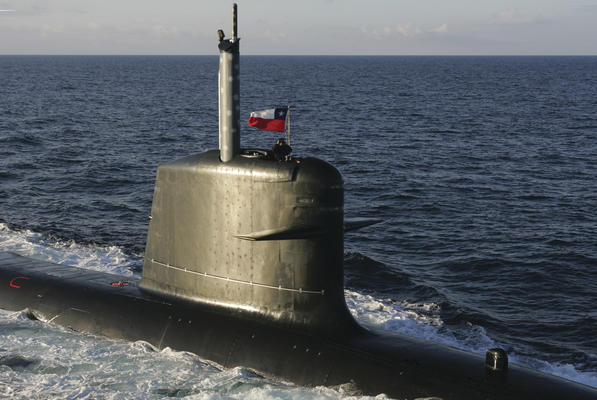Submarine periscopes and masts call on a wide variety of sensors, whether optical, optronic (electro-optical), or using electronic warfare technologies. They span the operational spectrum, from intelligence to engagement. Worldwide, only a handful of manufacturers have developed real end-to-end expertise in submarine masts and periscopes – and there’s only one in France: Safran.
ADM Staff Writers
Safran Electronics & Defense (formerly Sagem) calls on its centers of excellence in optronics, high-precision mechanics, stabilization and image processing to offer innovative submarine solutions.
Submarines are usually fitted with two types of periscopes. First, attack periscopes. Using an array of mirrors, the attack periscope gives the crew an exact view of their surroundings. This is an old optical principle, but now calls on the latest technologies. Modern periscopes also offer a very small head for reduced radar cross-section and wake, and to minimize the chance of being detected.
The second type is the observation periscope. Operated from a console for extended use, it is fitted with a wide range of optical and optronic sensors (infrared imagers, image intensifier cameras, video cameras, lasers), all in addition to ESM (electronic support measures) antennas.
"Until now, submarines were equipped with masts that went through the hull."
These two types of periscopes are generally used along with radar masts, telecom masts (radio, satellite), and possibly astral sighting masts to recalibrate navigation systems.
All of these types of masts now play a pivotal role in enhancing the value of the submarine as a combat platform, not only for blue water operations, but also in coastal regions, whether for intelligence or to support high-intensity conflicts. For instance, during major engagements by NATO forces, French nuclear attack submarines distinguished themselves in intelligence gathering missions by calling on their optronic masts.
Feedback from operations shows that the challenge is the design of sensor systems that combine high performance with the ability to operate at periscope depth, without leading to detection of the submarine.
Until now, submarines were equipped with masts that went through the hull. Accessible in the ship’s operations room, they entailed certain restrictions on the ship’s design. Furthermore, the design had to incorporate leak-tightness at all depths and resistance to collisions. But given the technological breakthroughs in recent decades – image intensification, video, infrared, lasers, gyro-stabilization and electronics – the time has come to jump to the next level: replace optical periscopes with non-penetrating optronic masts.
New masts are more compact and are housed in the conning tower, with the sensors being operated via multifunction consoles, in real time or delayed, to minimize as much as possible submersion time at periscope depth. They provide a key modernization solution for submarines already in service, and are an integral part of the innovative new generation of submarines. Their visual performance, combining video and infrared, offers longer range, flexibility and invaluable night vision.
 A Chilean Navy Scorpène class submarine with Safran masts/periscopes. Credit: DCNS
A Chilean Navy Scorpène class submarine with Safran masts/periscopes. Credit: DCNS
Furthermore, these new masts give ship designers greater freedom, especially in terms of operations and navigation room layouts, as well as their position in the hull. The absence of penetrating masts also improves safety. The concept of integrating multiple sensors on periscopes is now applied to new-generation non-penetrating optronic masts, such as the Series 30 Search Optronic Mast (SOM) from Safran.
The latest concept, reflecting an even more innovative attitude, is for a system combining attack and observation functions. Its main benefit is a mast head with a significantly reduced signature, enabling the submarine to collect intelligence at periscope depth while further minimizing the probability of detection. Safran’s new Series 30 Attack Optronic Mast (AOM) features a very compact design. It incorporates new-generation thermal imagers, an HDTV camera, laser rangefinder, video recorders, GPS receiver and ESM sensor.
Safran is the exclusive supplier of periscopes and optronic masts to the French navy, and contributes to all submarines produced by French naval shipyards DCNS, the preferred design partner for Sea 1000.
The Barracuda revolution
The Barracuda nuclear attack submarine program, slated to enter service with the Suffren class from 2017, will be the French navy’s first submarines equipped with non-penetrating optronic masts.
The new optical system designs for the Barracuda’s masts will enable it to capture very-high-quality images in just a few seconds, over a full 360° field-of-view. These masts incorporate a wide variety of sensors: high-resolution daytime color channel, infrared imagers and low-light cameras. Image processing is based on latest-generation algorithms and a very user-friendly interface, designed along with users. The images are displayed to the operator as compressed bands. On operator request, full-resolution zoom windows will be available in certain sectors.
In international markets, this new activity follows Safran’s success on the conventional Scorpène class submarines from DCNS. In early 2014, Safran signed a contract with Daewoo Shipbuilding & Marine Engineering of South Korea concerning SOM observation masts for its KSS-IIlI class ocean-going submarines. This same model was chosen by Saab Kockums in Sweden for its upcoming A26 submarines and the modernization of Gotland class subs. These masts are derived from the Series 30, now in production for Scorpène submarines in international markets and the future Suffren class.
Safran’s image processing system can be easily interfaced with the ship’s combat systems.
An Australian footprint
Safran, via its subsidiary Safran Electronics & Defense Australasia, has ambitious objectives for the Sea 1000 program.
Safran has a center of excellence in Bankstown, NSW, and provides local maintenance of its sensors used by Australian armed forces: infrared search & track systems (IRST) on Anzac frigates, LHDs and AWDs, the optronic sight for the Tiger ARH helicopter; inertial navigation systems for Collins class submarines, Huon class mine hunters and MRH90 helicopters.
For the Sea 1000 program, Safran is offering an approach based on local content, from production to support, calling on local subcontractors and based on products Australianisation.




